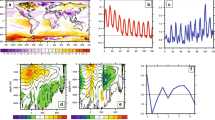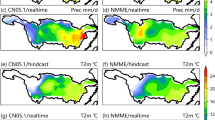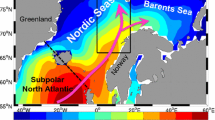Abstract
The interdecadal change in seasonal predictability and numerical models’ seasonal forecast skill in the Northern Hemisphere are examined using both observations and the seasonal hindcast from six coupled atmosphere-ocean climate models from the 21 period of 1960–1980 (P1) to that of 1981–2001 (P2). It is shown that the one-month lead seasonal forecast skill of the six models’ multi-model ensemble is significantly increased from P1 to P2 for all four seasons. We identify four possible reasons accounting for the interdecadal change of the seasonal forecast skill. Firstly, the numerical model’s ability to simulate the mean state, the time variability and the spatial structures of the sea surface temperature and precipitation over the tropical Pacific is improved in P2 compared to P1. Secondly, an examination of the potential predictability of the atmosphere, estimated by the ratio of the total variance to the variance due to the internal dynamics of the model atmosphere, reveals that the atmospheric potential predictability is significantly increased after 1980s which is mainly due to an increased influence of El Niño-Southern Oscillation signal over the North Pacific and North American regions. Thirdly, the long-term climate trends in the atmosphere are found to contribute, to some extent, to the increased seasonal forecast skill especially over the Eurasian regions. Finally, the improved ocean observations in P2 may provide better initial conditions for the coupled models’ seasonal forecast.















Similar content being viewed by others
References
Alessandri A, Borrelli A, Masina S et al (2010) The ingv-cmcc seasonal prediction system: improved ocean initial conditions. Mon Weather Rev 138:3634–3649
Balmaseda M, Vidard A, Anderson DLT (2008) The ECMWF ORA-S3 ocean analysis system. Mon Weather Rev 136:3014–3018
Boer G (2009) Climate trends in a seasonal forecasting system. Atmos Ocean 47:123–138
Brankovic C, Palmer T (2000) Seasonal skill and predictability of ecmwf provost ensembles. Q J R Meteorol Soc 126:2035–2067
Chowdary J, Xie SP, Lee JY, Kosaka Y, Wang B (2010) Predictability of summer northwest pacific climate in eleven coupled model hindcasts: local and remote forcing. J Geophys Res 115:D22121
Collins W et al (2008) Evaluation of the hadgem2 model. Tech Note HCTN 74, Met Off Hadley Cent, Exeter, UK. http://www.metoffice.gov.uk/publications/HCTN/index.html
Daget N, Weaver AT, Balmaseda MA (2009) Ensemble estimation of background-error variances in a three-dimensional variational data assimilation system for the global ocean. Q J R Meteorol Soc 135:1071–1094
Deser C, Knutti R, Solomon S, Philips AS (2012) Communication of the role of natural variability in future north american climate. Nat Clim Chang. doi:10.1038/NCLIMATE1562
Doblas-Reyes F, Hagedorn R, Palmer TN, Morcrette JJ (2006) Impact of increasing greenhouse gas concentrations in seasonal ensemble forecasts. Geophys Res Lett 33:L07708. doi:10.1029/2005GL025,061
Feng X, Delsole T, Hpuser P (2012) A method for estimating potential predictability: analysis of covariance. J Clim 25:5292–5308
Graham N (1992) Decadal scale climate variability in the 1970s and 1980s: observations and model results: decadal-to-century time scales of climate variability. Academic, New York
Grimm A, Sahai A, Ropelewski C (2006) Interdecadal variation in AGCM simulation skill. J Clim 19:3406–3419
Higgins R, Leetmaa A, Xue Y, Barnston A (2000) Dominant factors influencing the seasonal predictability of US precipitation and surface air temperature. J Clim 13:3994–4017
Hwang SO, Schemm JKE, Barnston AG, Kwon WT (2001) Long-lead seasonal forecast skill in far eastern asia using canonical correlation analysis. J Clim 14:3005–3160
Jeong HI, Ahn JB, Lee JY, Alessandri A, Hendon HH (2014) Interdecadal change of interannual variability and predictability of two types of enso. Clim Dyn (in press)
Jia XJ, Lin H (2011) Influence of forced large-scale atmospheric patterns on surface air temperature in china. Mon Weather Rev 139:830–852
Jia XJ, Lin H (2013) The possible reasons for the misrepresented long-term climate trends in the seasonal forecasts of HFP2. Mon Weather Rev. doi:10.1175/MWR-D-12-00302.1
Jia XJ, Lin H, Jacques D (2009) The influence of tropical Pacific forcing on the Arctic Oscillation. Clim Dyn 32:495–509
Jia XJ, Lin H, Lee JY, Wang B (2012) Season-dependent forecast skill of the dominant atmospheric circulation patterns over the pacific north-american region. J Clim 25:7248–7265
Jia XJ, Lee JY, Lin H, Alessandri A (2013) Interdecadal change in the northern hemisphere seasonal climate prediction skill: part I. the leading forced mode of atmospheric circulation. Clim Dyn. doi:10.1007/s00382-013-1988-1
Kalnay E, Kanamitsu M, Kistler R (1996) The ncep/ncar 40-year reanalysis project. Bull Am Meteorol Soc 77:437–471
Keenlyside N, Latif M, Botzet M, Jungclaus J, Schulzweida U (2005) A coupled method for initializing el nino southern oscillation forecasts using sea surface temperature. Tellus Ser A 57:340–356
Kim ST, Yu JY (2012) The two types of enso in cmip5 models. Clim Dyn Geophys Res Lett: 39:L11704
Kumar A, Hoerling M (1998) Annual cycle of pacific-north american seasonal predictability associated with different phase of ENSO. J Clim 13:3295–3308
Lee JY, Wang B (2014) Future change of global monsoon in the cmip5. Clim Dyn 42:101–119
Lee JY, Wang B, Kang IS, Kug JS et al (2010) How are seasonal prediction skills related to models performance on mean state and annual cycle? Clim Dyn 35:267–283
Lee JY, Wang B, Ding Q, Ha KJ, Ahn JB, Kumar A, Stern B, Alves O (2011) How predictable is the nh summer upper-tropospheric circulation. Clim Dyn 37:1189–1203
Lee JY, Lee SS, Wang B, Ha KJ, Jhun JG (2013) Seasonal prediction and predictability of the asian winter temperature variability. Clim Dyn 41:573–587
Lee JY, Wang B, Seo KH, Kug JS, Choi YS, Kosaka Y, Ha KJ (2014) Future change of northern hemisphere summer tropical-extratropical teleconnection in cmip5 models. J Clim. doi:10.1175/JCLI-D-13-00261.1
Lee SS, Lee JY, Ha KJ, Wang B, Schemm JKE (2011) Deficiencies and possibilities for long-lead coupled climate prediction of the western north pacific-east asian summer monsoon. Clim Dyn 36:1173–1188
Luo JJ, Behera KS (2011) Impact of global ocean surface warming on seasonal-to-interannual climate prediction. J Clim 24:1626–1646
Melia DS (2002) A global coupled sea ice-ocean model. Ocean Model 4:137–172
Mitchell TD, Jones PD (2005) An improved method of constructing a database of monthly climate observations and associated high-resolution grids. Int J Climatol 25:693–712
Nakaegawa T, Kanamitsu M (2004) Interdecadal trend of prediction skill in an ensemble amip-type experiment. J Clim 17:2881–2889
Peng P, Kumar A, Barnston A, Goddard L (2000) Simulation skills of the sst-forced global climate variability of the ncep-mrf9 and scripps/mpi echam3 models. J Clim 13:3657–3679
Rayner N, Parker DE, Horton EB, Folland CK, Alexander LV, Rowell DP, Kent EC, Kaplan A (2003) Global analyses of sea surface temperature, sea ice, and night marine air temperature since the late nineteenth century. J Geophys Res. doi:10.1029/2002JD002670
Sardeshmukh P, Hoskins BJ (1988) The generation of global rotational flow by steady idealized tropical divergence. J Atmos Sci 45:1228–1251
Shabbar A, Barnston AG (1996) Skill of seasonal climate forecasts in canada using canonical correlation analysis. Mon Weath Rev 124:2307–2385
Shukla J, Anderson J, Baumhefner D, Brankovic C, Chang Y, Kalnay E, Marx L, Palmer T, Paolino D, Ploshay J, Schubert S, Straus D, Suarez M (2000) Dynamical seasonal prediction. Bull Am Meteorol Soc 11:2593–2606
Stockdale T, David L, Anderson T, Magadalena A (2011) Ecmwf seasonal forecast system 3 and its prediction of sea surface temperature. Clim Dyn 37:344–471
Tang Y, Deng Z, Zhou X, Cheng Y (2008) Interdecadal variation of enso predictability in multiple models. J Clim 21:4811–4833
Wallace JM, Guztler D (1981) Teleconnections in the geopotential height field during the Northern Hemisphere winter. Mon Weather Rev 109:784–812
Wang B (1995) Interdecadal changes in el nino onset in the last four decades. J Clim 8:267–285
Wang B, Lee JY, Shukla J, Kang IS, Park CK et al (2009) Advance and prospectus of seasonal prediction: assessment of apcc/clipas 14-model ensemble retrospective seasonal prediction (1980–2004). Clim Dyn 33:93–117
Weisheimer A, Doblas-Reyes FJ,Palmer TN (2009) Ensembles: a new multi-model ensemble for seasonal-to-annual predictions—skill and progress beyond demeter in forecasting tropical Pacific ssts. Geophys Res Lett 36:L21711
Xue Y, Smith T, Reynolds W (2003) Interdecadal changes of 30-year sst normal during 1871–2000. J Clim 16:1601–1612
Yang J, Bao Q, Wang XC, Zhou TJ (2012) The tropical intraseasonal oscillation in samil coupled and uncoupled general circulation models. Adv Atmos Sci. doi:10.1007/s00376-011-1087-3
Zhang Y, Wallace J, Battisti D (1997) Enso-like interdecadal variability: 1900–93. J Clim 10:1004–1020
Zhong A, Hendon H, Alves O (2005) Indian ocean variability and its association with ENSO in a global coupled model. J Clim 18:3634–3649
Zwiers F (1996) Interannual variability and predictability in an ensemble of amip climate simulations conducted with the ccc gcm2. Clim Dyn 12:825–847
Acknowledgments
This research was jointly funded by National Natural Sciences Fundation of China (grant 41105037) and by the Natural Science and Engineering Research Council of Canada (NSERC). Jia is also supported by the Fundamental Research Funds for the Central Universities (grant 2012XZZX012) and the R&D Special Fund for Public Welfare Industry(meteorology) (grant GYHY201106035). Lee and Ha were supported by the National Research Foundation of Korea through a Global Research Laboratory (GRL) grant (MEST 2011-0021927). This work was partially supported by the APEC Climate Center (APCC) international research project. We are grateful to the two reviewers for their helpful suggestions on improving our paper.
Author information
Authors and Affiliations
Corresponding author
Rights and permissions
About this article
Cite this article
Jia, X., Lee, JY., Lin, H. et al. Interdecadal change in the Northern Hemisphere seasonal climate prediction skill: part II. predictability and prediction skill. Clim Dyn 43, 1611–1630 (2014). https://doi.org/10.1007/s00382-014-2084-x
Received:
Accepted:
Published:
Issue Date:
DOI: https://doi.org/10.1007/s00382-014-2084-x




